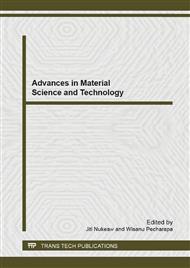p.22
p.27
p.32
p.37
p.42
p.47
p.53
p.59
p.64
Environmental Treatment for Perfect Spray Photoresist Morphology and Analysis
Abstract:
A homogeneous photoresist for IC or read-write data storage head fabrication requires a certain flowing of the resist film on the topography surface for at least few micrometers, thus defining certain minimal resist viscosity for the remaining solvent concentration for spraying technique. The high photoresist solvent evaporates during flight (between spray nozzle and substrate) prevents the droplets from sticking to the substrate and causes a rough surface. The limitation of very low photoresist viscosity for micro droplets spraying is a drawback of the technique. Because of very low viscosity of spray coating resist, nitrogen in spray coating system will act as 2 functions. First is for spread photoresist to be micro droplets. In the same time nitrogen can dry the small droplet before locating to substrate and perform obstacle for UV exposure. The unsatisfied resist was protected UV light during exposure cause pattern deformation. The study was investigated the particles which always found on finished photoresist surface spraying, and aimed to find the solution to decrease or eliminate dry droplet. EDX identified element of the obstacle particles is photoresist. They are dry resist ball about 1 – 6 um size. The selected chemicals for the investigation to dilute or dissolve the resist ball, IPA, acetone and mixing solution between 70% IPA and 30% acetone. Acetone is most effective. The proper time for dissolve dry resist ball with slight photoresist degradation is 40 s, very short because of high vapor pressure of acetone at room temperature. There is a trade-off between resist surface smoothness and reflow characteristics. Final resist thickness with the acetone vaporization condition will be achieved 7.5 um as expectation with less corner coverage problem. SEM and AFM images were confirmed that morphology after acetone vapor exposure was improved. Surface roughness was reduced for 3 times to 8 nm with acetone vaporization environment. The end of this study was include on corrosion characterization for magnetic CoFe alloys underlying photoresist to explore the method to determine photoresist type in future manufacturing which necessary to run the process with sensitive material. With AZ4999 spray photoresist protection indicated corrosion rate of CoFe films was reduced for 100 times compare to bare films.
Info:
Periodical:
Pages:
42-46
Citation:
Online since:
September 2013
Keywords:
Price:
Сopyright:
© 2013 Trans Tech Publications Ltd. All Rights Reserved
Share:
Citation:


